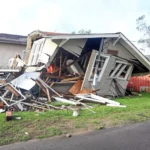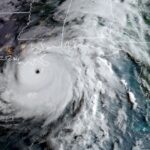 Preparing for climate change often focuses on the steps you can do to mitigate your environmental impact or on what systemic steps will be required to make a meaningful transition away from fossil fuels towards a cleaner energy future. These are important issues, but there is another aspect of climate change that often goes unaddressed that I want to discuss with you all today. How should we prepare for climate disasters?
Preparing for climate change often focuses on the steps you can do to mitigate your environmental impact or on what systemic steps will be required to make a meaningful transition away from fossil fuels towards a cleaner energy future. These are important issues, but there is another aspect of climate change that often goes unaddressed that I want to discuss with you all today. How should we prepare for climate disasters?
Natural disasters aren’t anything new. Tornadoes, floods, wildfires, hurricanes, and so many other hazards are an unfortunate part of life. However, climate change is projected to increase both the frequency and intensity of such hazards. This means you might be faced with an unexpected flood or storms far stronger than you have experienced in the past. With this in mind, it is important to take steps to make sure you are safe should one of these hazards strike in your community.
 The most important step you can take is to familiarize yourself with what dangerous weather hazards are common in your community. The National Weather Service has many resources that can help one learn about what types of storms or other dangers are common to an area. More importantly, these resources also provide information about how to prepare for such events, what the warning signs might be, and how to protect yourself during and after such an event. I would highly recommend checking out Weather Ready Nation to get more information like this[1].
The most important step you can take is to familiarize yourself with what dangerous weather hazards are common in your community. The National Weather Service has many resources that can help one learn about what types of storms or other dangers are common to an area. More importantly, these resources also provide information about how to prepare for such events, what the warning signs might be, and how to protect yourself during and after such an event. I would highly recommend checking out Weather Ready Nation to get more information like this[1].
In a more immediate sense, it’s also wise to consider what supplies and tools you can have on hand in order to prepare for severe weather. A basic weather radio is a commonly suggested tool for those living in Tornado Alley. It’s also wise to keep a basic cache of essential supplies for times of extreme weather. Bandages, a small store of clean water (jugs are a common choice), some non perishable food, weather proof matches, etc. You never know when you might be out of power or in a bind for a few days, so keeping these basics can really help make a difference.
Lastly, its wise to consider more specialized materials based on the weather hazards you might face. For example, with climate change making hurricanes more severe and frequent, it may be wise to familiarize yourself and your family with hurricane evacuation routes. For those in places prone to tornadoes, practice safety drills may be a good step. Those vulnerable to fire may want to be familiar with their evacuation routes, as with hurricanes, or work on developing a go-back, just in case. Of course, investing in portable solar rechargers for electronics so you can continue to access information is never a bad choice either.
In summary, climate change may make natural hazards more dangerous, but you can still take steps to be prepared. These steps don’t have to come at the cost of personal steps to reduce and recycle either. So keeping these tips in mind can help you both protect the environment, and yourself.
[1] https://www.weather.gov/wrn/
